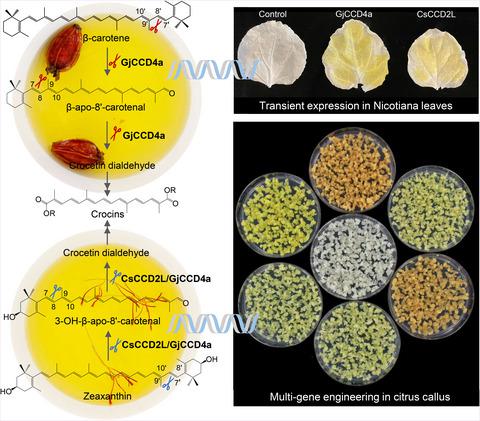当前位置:
X-MOL 学术
›
Plant Biotech. J.
›
论文详情
Our official English website, www.x-mol.net, welcomes your
feedback! (Note: you will need to create a separate account there.)
Gardenia carotenoid cleavage dioxygenase 4a is an efficient tool for biotechnological production of crocins in green and non-green plant tissues
Plant Biotechnology Journal ( IF 10.1 ) Pub Date : 2022-07-29 , DOI: 10.1111/pbi.13901 Xiongjie Zheng 1 , Jianing Mi 1 , Aparna Balakrishna 1 , Kit Xi Liew 1 , Abdugaffor Ablazov 1 , Rachid Sougrat 2 , Salim Al-Babili 1
Plant Biotechnology Journal ( IF 10.1 ) Pub Date : 2022-07-29 , DOI: 10.1111/pbi.13901 Xiongjie Zheng 1 , Jianing Mi 1 , Aparna Balakrishna 1 , Kit Xi Liew 1 , Abdugaffor Ablazov 1 , Rachid Sougrat 2 , Salim Al-Babili 1
Affiliation

|
Crocins are beneficial antioxidants and potential chemotherapeutics that give raise, together with picrocrocin, to the colour and taste of saffron, the most expensive spice, respectively. Crocins are formed from crocetin dialdehyde that is produced in Crocus sativus from zeaxanthin by the carotenoid cleavage dioxygenase 2L (CsCCD2L), while GjCCD4a from Gardenia jasminoides, another major source of crocins, converted different carotenoids, including zeaxanthin, into crocetin dialdehyde in bacterio. To establish a biotechnological platform for sustainable production of crocins, we investigated the enzymatic activity of GjCCD4a, in comparison with CsCCD2L, in citrus callus engineered by Agrobacterium-mediated supertransformation of multi genes and in transiently transformed Nicotiana benthamiana leaves. We demonstrate that co-expression of GjCCD4a with phytoene synthase and β-carotene hydroxylase genes is an optimal combination for heterologous production of crocetin, crocins and picrocrocin in citrus callus. By profiling apocarotenoids and using in vitro assays, we show that GjCCD4a cleaved β-carotene, in planta, and produced crocetin dialdehyde via C30 β-apocarotenoid intermediate. GjCCD4a also cleaved C27 β-apocarotenoids, providing a new route for C17-dialdehyde biosynthesis. Callus lines overexpressing GjCCD4a contained higher number of plastoglobuli in chromoplast-like plastids and increased contents in phytoene, C17:0 fatty acid (FA), and C18:1 cis-9 and C22:0 FA esters. GjCCD4a showed a wider substrate specificity and higher efficiency in Nicotiana leaves, leading to the accumulation of up to 1.6 mg/g dry weight crocins. In summary, we established a system for investigating CCD enzymatic activity in planta and an efficient biotechnological platform for crocins production in green and non-green crop tissues/organs.
中文翻译:

栀子类胡萝卜素裂解双加氧酶 4a 是在绿色和非绿色植物组织中生物技术生产藏红花素的有效工具
藏红花素是有益的抗氧化剂和潜在的化疗药物,与苦藏红花素一起分别提高最昂贵香料藏红花的颜色和味道。藏红花素由藏红花酸二醛形成,藏红花酸是通过类胡萝卜素裂解双加氧酶 2L (CsCCD2L) 在藏红花中从玉米黄质中产生的,而来自栀子花(藏红花素的另一个主要来源)的 GjCCD4a在细菌中将包括玉米黄质在内的不同类胡萝卜素转化为藏红花酸二醛。为了建立可持续生产藏红花素的生物技术平台,我们研究了农杆菌介导的多基因超转化工程的柑橘愈伤组织和瞬时转化的本塞姆氏烟草叶片中 GjCCD4a 的酶活性,并与 CsCCD2L 进行比较。我们证明, GjCCD4a与八氢番茄红素合酶和β-胡萝卜素羟化酶基因的共表达是柑橘愈伤组织中异源生产藏红花酸、藏红花素和苦藏红花素的最佳组合。通过分析类胡萝卜素并使用体外测定,我们表明 GjCCD4a在植物中裂解 β-胡萝卜素,并通过 C 30 β-类胡萝卜素中间体产生藏红花酸二醛。 GjCCD4a还裂解C 27 β-类胡萝卜素,为C 17 -二醛生物合成提供新途径。过表达 GjCCD4a 的愈伤组织系在色质体样质体中含有更高数量的质体球,并且八氢番茄红素、C17:0 脂肪酸 (FA) 和 C18:1顺式-9 和 C22:0 FA 酯的含量增加。 GjCCD4a 在烟草叶中表现出更广泛的底物特异性和更高的效率,导致累积高达 1.6 mg/g 干重的藏红花素。总之,我们建立了一个研究植物中CCD酶活性的系统和一个在绿色和非绿色作物组织/器官中生产藏红花素的高效生物技术平台。
更新日期:2022-07-29
中文翻译:

栀子类胡萝卜素裂解双加氧酶 4a 是在绿色和非绿色植物组织中生物技术生产藏红花素的有效工具
藏红花素是有益的抗氧化剂和潜在的化疗药物,与苦藏红花素一起分别提高最昂贵香料藏红花的颜色和味道。藏红花素由藏红花酸二醛形成,藏红花酸是通过类胡萝卜素裂解双加氧酶 2L (CsCCD2L) 在藏红花中从玉米黄质中产生的,而来自栀子花(藏红花素的另一个主要来源)的 GjCCD4a在细菌中将包括玉米黄质在内的不同类胡萝卜素转化为藏红花酸二醛。为了建立可持续生产藏红花素的生物技术平台,我们研究了农杆菌介导的多基因超转化工程的柑橘愈伤组织和瞬时转化的本塞姆氏烟草叶片中 GjCCD4a 的酶活性,并与 CsCCD2L 进行比较。我们证明, GjCCD4a与八氢番茄红素合酶和β-胡萝卜素羟化酶基因的共表达是柑橘愈伤组织中异源生产藏红花酸、藏红花素和苦藏红花素的最佳组合。通过分析类胡萝卜素并使用体外测定,我们表明 GjCCD4a在植物中裂解 β-胡萝卜素,并通过 C 30 β-类胡萝卜素中间体产生藏红花酸二醛。 GjCCD4a还裂解C 27 β-类胡萝卜素,为C 17 -二醛生物合成提供新途径。过表达 GjCCD4a 的愈伤组织系在色质体样质体中含有更高数量的质体球,并且八氢番茄红素、C17:0 脂肪酸 (FA) 和 C18:1顺式-9 和 C22:0 FA 酯的含量增加。 GjCCD4a 在烟草叶中表现出更广泛的底物特异性和更高的效率,导致累积高达 1.6 mg/g 干重的藏红花素。总之,我们建立了一个研究植物中CCD酶活性的系统和一个在绿色和非绿色作物组织/器官中生产藏红花素的高效生物技术平台。











































 京公网安备 11010802027423号
京公网安备 11010802027423号